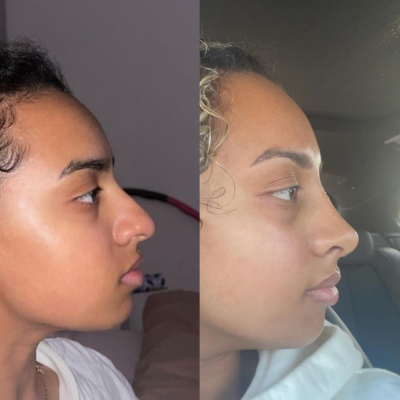A deviated septum is a common condition that affects millions of people worldwide. While many live with this condition without even realising it, for others, it can cause significant discomfort and impact their quality of life. In this blog, we will explore what a deviated septum is, its symptoms, and the various treatment options available, including surgical correction.
What is deviated septum?
The septum is the cartilage and bone that separates the two nostrils in your nose. Ideally, this septum should divide your nostrils into two equal passages. However, for many people, the septum is slightly off-centre or crooked. This condition is known as a deviated septum.
A deviated septum can occur due to several reasons. In some cases, people are born with this condition, while in others, it can result from an injury or trauma to the nose. In severe cases, a deviated septum can block one side of the nose, reducing airflow and making it difficult to breathe. This condition can also increase the risk of sinus infections, nosebleeds, and other complications.
Symptoms of a deviated septum
Not everyone with a deviated septum experiences symptoms. However, when symptoms do occur, they can range from mild to severe, depending on the degree of deviation. Some of the most common symptoms include:
Nasal congestion: One of the most common symptoms of a deviated septum is nasal congestion. Often, the side of the nose that is narrower due to the deviation is more likely to feel congested or blocked.
Frequent nosebleeds: The uneven surface of a deviated septum can cause the nasal passages to become dry, leading to frequent nosebleeds.
Difficulty breathing through the nose: A deviated septum can make it more difficult to breathe, especially through one nostril.
Sinus infections: Due to the blockage of nasal passages, individuals with a deviated septum may experience frequent sinus infections, which can cause pain, pressure, and headaches.
Noisy breathing during sleep: People with a deviated septum may experience noisy breathing or snoring, particularly during sleep. In some cases, this can also lead to sleep apnea, a condition in which breathing repeatedly stops and starts during sleep.
Facial pain or headaches: In severe cases, a deviated septum can cause facial pain or headaches, especially around the nasal area.
If you experience any of these symptoms and suspect you may have a deviated septum, it's essential to consult with a healthcare professional for a proper diagnosis.
How is a deviated septum diagnosed?
A diagnosis of a deviated septum can be made through a thorough examination of your nose by a healthcare professional, such as an ear, nose, and throat (ENT) specialist. During the examination, your doctor may use a nasal speculum to view the inside of your nose and assess the shape and position of your septum.
In some cases, additional tests, such as a nasal endoscopy or imaging studies like a CT scan, may be recommended to evaluate the severity of the deviation and determine the best course of treatment.
Treatment options for a deviated septum
Fortunately, there are several treatment options available for individuals with a deviated septum. Depending on the severity of your symptoms and the degree of deviation, your doctor may recommend either non-surgical or surgical interventions.
Non-surgical treatments
For mild cases of a deviated septum, non-surgical treatments may be sufficient to manage symptoms. These treatments focus on relieving the symptoms associated with the condition, rather than correcting the deviation itself. Some common non-surgical treatments include:
Nasal decongestants: These medications can help reduce swelling in the nasal passages, improving airflow and making it easier to breathe.
Antihistamines: If your symptoms are caused or worsened by allergies, antihistamines can help reduce inflammation and improve nasal congestion.
Nasal corticosteroid sprays: These sprays can help reduce inflammation in the nasal passages and relieve symptoms such as nasal congestion and sinus pressure.
Saline nasal sprays: Saline sprays can help moisturise the nasal passages, reducing dryness and preventing nosebleeds.
While these treatments can help alleviate symptoms, they do not address the underlying issue of the deviated septum. For individuals with more severe symptoms or complications, surgical intervention may be necessary.
Septoplasty: Surgical correction for a deviated septum
Septoplasty is the most common surgical procedure used to correct a deviated septum. This procedure aims to straighten the septum and improve airflow through the nose.
During a Septoplasty, the surgeon makes an incision inside the nostril and carefully removes or reshapes the deviated portion of the septum. The goal is to create a more even and symmetrical nasal passage, allowing for better airflow and reducing symptoms such as nasal congestion and breathing difficulties.
Septoplasty is usually performed under general anaesthesia and takes between 30 to 90 minutes, depending on the complexity of the procedure. Most patients can go home the same day, although they will need some time to recover fully.
The benefits of Septoplasty
Septoplasty offers several benefits for individuals with a deviated septum, including:
Improved breathing: One of the primary benefits of Septoplasty is improved airflow through the nasal passages. This can make it easier to breathe, particularly through both nostrils.
Reduced nasal congestion: By correcting the deviation, Septoplasty can help reduce nasal congestion and improve overall nasal function.
Fewer sinus infections: With improved airflow and drainage, individuals who undergo Septoplasty are less likely to experience recurrent sinus infections.
Improved quality of life: For many patients, the improvement in breathing and reduction in symptoms can significantly enhance their quality of life, particularly when it comes to sleep and daily activities.
Cosmetic considerations
In some cases, individuals with a deviated septum may also have concerns about the appearance of their nose. In these instances, a Rhinoplasty may be performed in conjunction with a septoplasty to improve both the function and appearance of the nose.
For those interested in exploring cosmetic or functional nasal surgery, Pall Mall offers a range of cosmetic surgery options tailored to the individual’s needs. Read about Pall Mall patient Kerry Katona's transformative surgery.
Choosing the right surgeon
If you are considering surgery to correct a deviated septum, choosing the right surgeon is crucial for achieving the best possible outcome. It’s important to select a highly qualified and experienced ENT specialist who is skilled in performing Septoplasty.
At Pall Mall, we have a team of expert surgeons including renowned professionals such as Professor Ullas Raghavan, a ENT and Facial Plastic Surgeon with extensive experience in Septoplasty and other nasal surgeries.
A deviated septum is a common condition that can cause a range of symptoms, from nasal congestion to difficulty breathing. While non-surgical treatments may provide relief for mild cases, surgical intervention through Septoplasty is often the best solution for individuals with more severe symptoms.
If you believe you have a deviated septum and are considering surgery, it's essential to consult with an experienced ENT specialist to determine the best course of action. With the right treatment, you can enjoy improved breathing, better overall health, and a higher quality of life.
To find out more about Septoplasty or any other cosmetic surgery procedures, contact our team.






